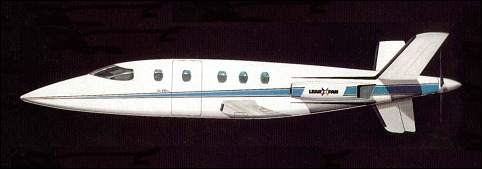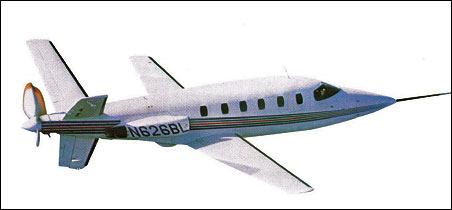|
| The story of the LearFan is a complex one. Designed by Bill Lear as a
cheaper alternative to business jets, with nearly the same performance
but a pusher propeller, the LearFan became the first business aircraft with a
composite (carbon fibre) structure, as opposed to conventional metal
construction. Unfortunately in the late 1970s this was all a bit radical for the
Federal Aviation Administration, who repeatedly refused certification of the
LearFan. Bill Lear died in 1978 and his widow carried on the programme,
seeing the first of three prototypes fly in 1981. Problems with the gearbox,
which managed the two PT-6 turboprops on a common shaft, and structural
problems with the new composite materials caused costs to escalate, and
despite orders and options at one time for over 130 aircraft, the company
went bankrupt in 1984 with debts approaching 500 million dollars. FACTS AND FIGURES © The LearFan was made almost
entirely of graphite/epoxy and
Kevlar composite materials, and
it was one of the first aircraft to
make such extensive use of
them. © Some critics have said the LearFan
was designed too much like a
conventional aircraft made of
composites to make the best use of
the strengths of these new materials. © Putting the propeller at the rear
reduced drag and helped the
LearFan approach jet speeds. © Some unfinished LearFans were
used by NASA to test composite
structures, being dropped from
towers in controlled crashes. © To meet a deadline of the end
of 1980, the LearFan's first
flight was officially recorded as
'December 32nd'.
| CREW | 2 |
| PASSENGERS | 8 |
| ENGINE | 2 x 650hp Pratt & Whitney PT6B 35F tutboshafts |
| WEIGHTS |
| Take-off weight | 3334 kg | 7350 lb |
| DIMENSIONS |
| Wingspan | 11.99 m | 39 ft 4 in |
| Length | 12.50 m | 41 ft 0 in |
| Height | 3.70 m | 12 ft 2 in |
| PERFORMANCE |
| Max. speed | 684 km/h | 425 mph |
| David, e-mail, 09.06.2010 08:07 Even with the gearbox being named the single point failure it still met the type design as far as the safeties were concerned. The safeties being if the gearbox ran out of oil as the temp increased would melt a wax block internal to provide lubrication for continued operation to land safely. The engine runs on Christmas of 1979 with no oil in the gearbox were proven to meet a safe operation for many hours. Had the FAA not created so many reasons for this aircraft not to be certified, such as LEAR being required to make everything three times more compliant than the FAR's rules, we would have seen hundreds of these awesome vehicles on today's market. The gearbox in my opinion was the authorities final scapegoat to not certify the aircraft because they did not understand the technological advance of this aircraft! I would like to take the time to thank the entire LEAR FAN Team for inspiring me in my aviation career, oh so many childhood memories! I can tell you in 1999 when Moya sang at my wedding reception she still believed and was still excited about the accomplishments of the LEAR FAN. Come on LEAR FAN 2 - "Don't tell me it can't be done, We did it!" - Quote from Moya Olsen Lear. reply | | tfm, e-mail, 21.08.2010 21:31 It was a good idea but if you look at the three competitive entries in that market, Piagio 180, Beech Starship 2000, and LearFan 2100; what do the two failures have in common? LINDEN BLUE. Don't blame the FAA for decisions made by management. reply | | Doug Rodrigues, e-mail, 13.03.2010 11:19 I actually got to see this thing fly at the Stead Airport north of Reno, Nv. during the flight testing. If it hadn't been for the manufacturer of the transmission who failed to produce it as exactly per design, the plane would probably be flying now. reply | | phil, e-mail, 16.02.2010 15:55 John you're behind the times. Check out the twin contra rotating 4 bladed props on the Fairey Gannet anti-submarine aircraft, built in the 1950's by the British ! reply | |
| | Jim Fackler, e-mail, 25.01.2010 02:08 Not only the single propeller - but the single gearbox - was problematic. As for a contrarotating prop with only one prop running... Dynamically that would give the prop engineers a headache of monumental proportions. Even the TU-95 either runs both or nothing. Under power on the ground the LF2100 rumbled like a freight train... reply | | dB, e-mail, 01.10.2009 08:20 Note corrected email address, a late-in-the-evening error. reply | | dB, e-mail, 01.10.2009 08:17 I worked the summer of 1980 at Lear Fan before a flying prototype was built. I ironically found the pace somewhat slow, having come from construction where a moment is never wasted. Nonetheless, it was extremely exciting working with something that was so far ahead of its day. I marvel at the design and spec's for this aircraft today, even in comparison to today's extremely advanced ships that incorporate much of the same technology. John's idea of circumventing the single gearbox with a contra-rotating prop design is brilliant. Too bad it wasn't considered in the original development. reply |
| John, e-mail, 27.10.2008 21:27 I followed this planes development when I was a kid and I became a huge fan. Sadly the Feds felt it would not be safe due to 2 engines turning a single blade. This resulted in it not getting its certification.
I opened a thread in Yahoo Answers to see if it would be possible to build the Lear Fan, but using 2 blades instead of one. How? By using contra rotating blades, but each powered by its own engine. My hope is the feds would see this as safer, but knowing them they would nix it just because it is different.
I guess the Piaggio Avanti comes pretty close, but it using pushers in a side by side configuration and is not quite as efficient, but it comes pretty close. While you are at it, look up the B-36 pusher. reply |
| Zade, e-mail, 29.06.2008 23:01 are they for sale how much,who sells them reply | | Richard, e-mail, 28.02.2008 10:41 hey where can i get detailed dimensions for this plane? reply | | Joseph, e-mail, 01.11.2007 00:49 Love the idea rear mounted power plant to reduce cabin noise reply |
|
Do you have any comments?
|
| 
All the World's Rotorcraft |



 dB
dB John
John



I worked at Learfan 1978 to 1985 in structure design, aerodynamics then Advanced design. We had a look at contras for a next model and even dug up lots of data on the WWII Douglas XB-42. Contras would have been too heavy in the back end to balance the aircraft and wouldn't have solved the failure issue of a bearing or structural failure of having one shaft inside another. We already had big issues with aft CG problems, and it was one of two drivers for the 1 ft fuselage stretch. It wasn't driven by a marketing effort by Linden Blue has has been claimed. I know, I was in the meetings and did the revised lofts for the stretch. It actually should have been 18 inches to acheive best balance.
Piaggio Avanti is a masterpiece example given its larger diameter fuselage is more efficient than Learfan, we had laid out a larger follow-on Learfan configuration with almost identical weight and performance specs including the larger more efficient PT6-66 engines. Piagio actually met their specs and is a fair representation of what a larger faster Learfan would have been,
My weight analysis showed we didn't save weight with composites for a lot of detail reasons, except for the Kevlar propeller and carbon driveshafts.
reply